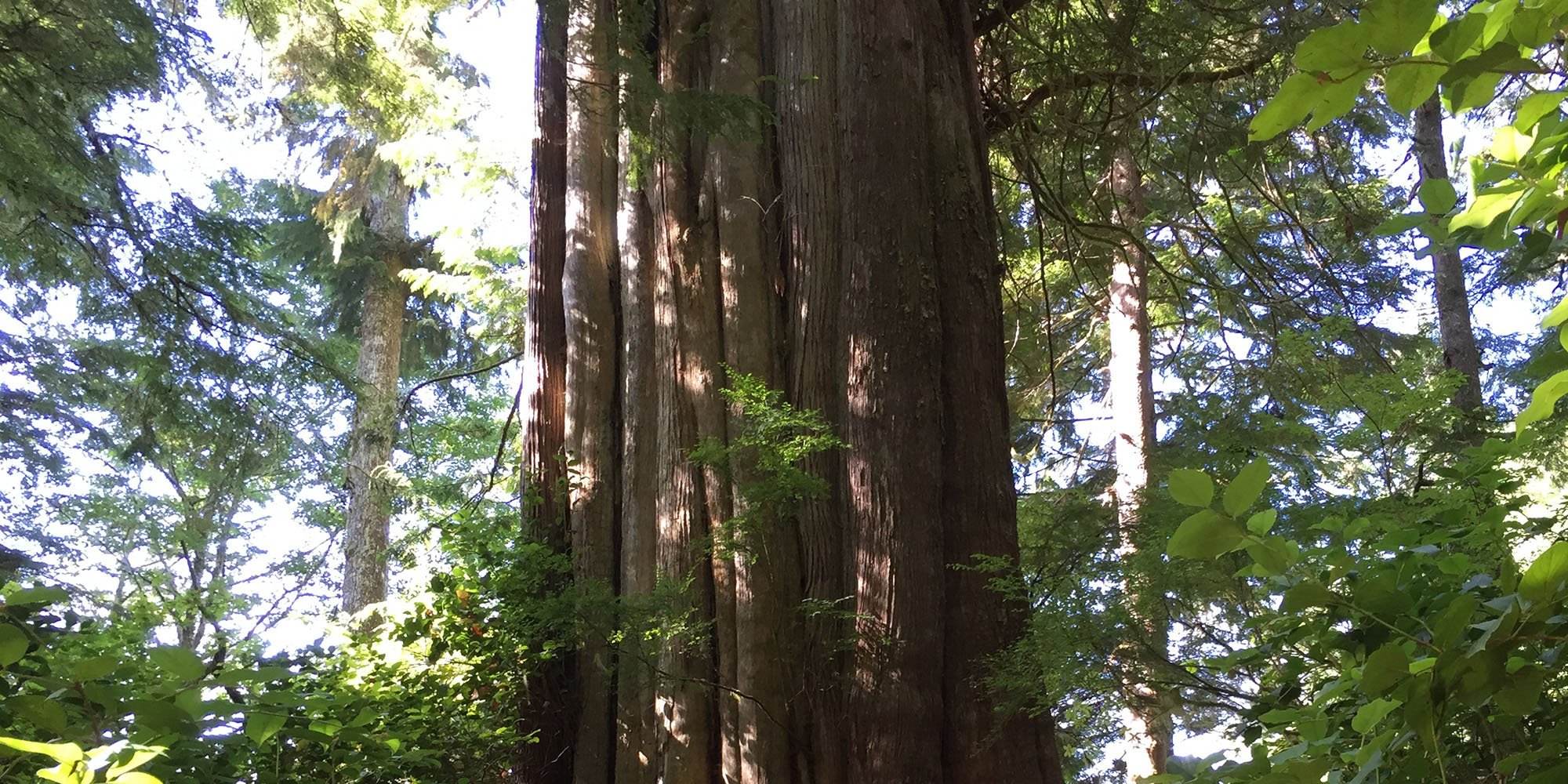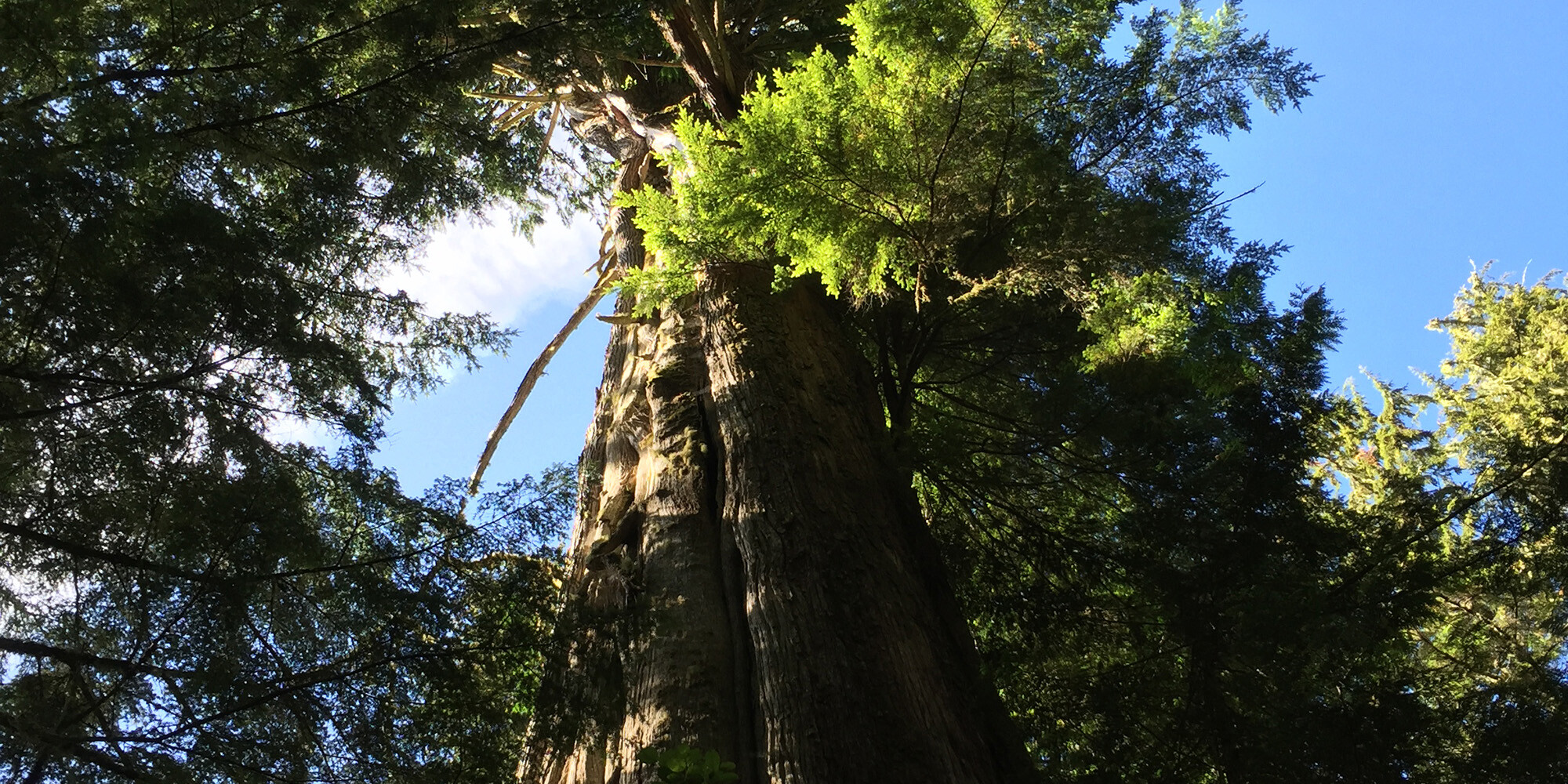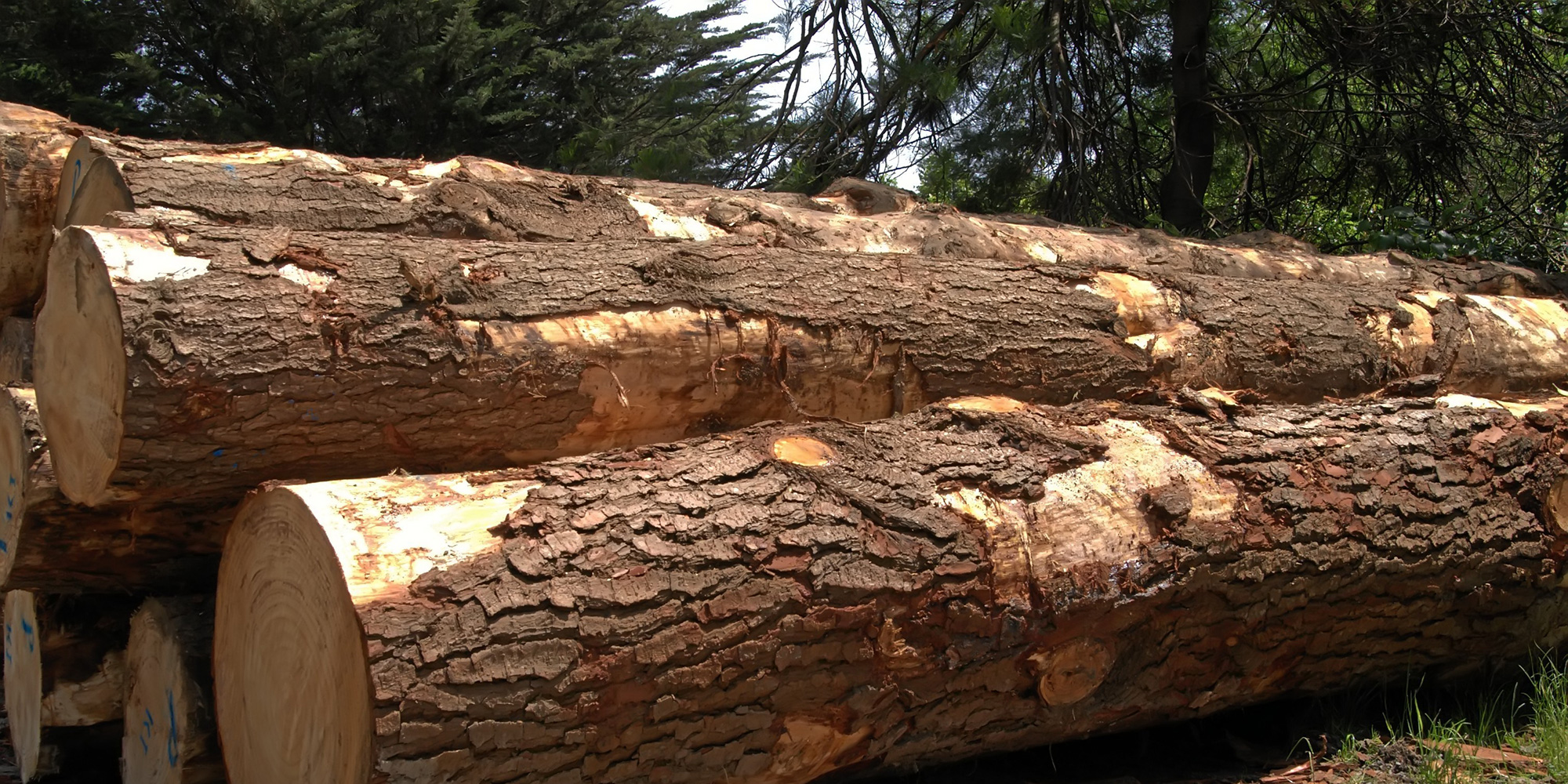Meares Island Case, 1985
Martin [1], Supreme Court & Court of Appeal of British Columbia 1985 - ongoing Banner of the Nuu-Chah-Nulth First Nations' People, the original...

Since the Truth and Reconciliation Commission released its summary report containing 94 Calls- to-Action we have written a series of articles on what various organizations can do towards reconciliation. We have articles on what local governments, municipalities, dioceses and schools are implementing or could implement to reset their relationship with Indigenous people. In this article, we visit the forestry and reconciliation. We provide an overview and then focus on British Columbia as BC is historically the biggest producer of forest products and its forestry/Indigenous relations have progressed since the infamous “War in the Woods” era.
So, first some background basics. Indigenous-forestry relations fall under both the federal government (controlling and directing issues related to Indigenous Peoples) and provincial and territorial governments. The management and use of forests, on the other hand, is primarily a provincial and territorial responsibility with those governments holding management authority over forest resources on most public lands. Private companies apply to provincial/territorial authorities for permission to conduct logging and production activities.
The majority of all lands in Canada are held by governments in the name of the monarch and are often called Crown Lands.* About 89% of Canada's land area (8,886,356 km²) is Crown Land, which may either be federal (41%) or provincial (48%); the remaining 11% is privately owned. In BC, 94% of the land is provincial crown land while 1% is federal crown land, including reserves, defence lands and federal harbours; 5% is privately owned. [1]
*Although in places Aboriginal Title represents an encumbrance on the Crown's title so I would recommend avoiding the use of Crown Lands in conversation to avoid triggering intense debate.
The majority of Indigenous communities are in or closely associated with forests, and about 1.4 million hectares (3.46 million acres) of reserve lands across the country are suitable for resource uses such as forestry, hunting, trapping, fishing and gathering herbs and medicinal plants. For many Indigenous communities, having recognized rights and a role in forestry has come at the high cost of lengthy legal battles, boycotts, barricades and negotiations. Including Indigenous Peoples in forestry plans is considered by some companies a hindrance, an inconvenience and an additional cost. Provincial governments sometimes find themselves caught in the middle trying to uphold treaty rights and meeting obligations to forestry companies and local economies dependent on forestry.
Since the 1960s, Aboriginal peoples have sought both greater recognition of their rights and increased autonomy, through political negotiations, public protests and legal challenges. This includes seeking recognition of their rights to forestlands already allocated to forestry companies, a situation that involves both the federal government (responsible for Indians) and provincial authorities (responsible for lands and forests).” [2] The situation has improved though. “Collectively, First Nations now hold approximately 10.4% of the national wood supply, an increase of 7.5 million m3 or 64% in volume from our last report in 2007, and a 140% increase since our first report in 2003.[3]
BC is the most important timber producer in the country, with 51.74 million hectares of timber-productive lands. There are 198 First Nation communities in the province and Indigenous forest lands (mainly reserves) cover approximately 198,000 hectares.
British Columbia has been renowned for the quality of its timber and forest products since Europeans first visited in the late 1700s. By the time BC entered confederation in 1871, the province was recognized globally for the superior quality of its timber. But long before then these same forests were crucial to the First Peoples who had inhabited the land since time immemorial. Forests are the source of cultural traditions, spiritual knowledge, traditional foods and revenue. Early logging practices did not factor in sustainability, the environment, Indigenous relationship to the land or the traditional and cultural significance of the forests to First Peoples - the rate that the forests were being logged and ecosystems destroyed with no regard for Indigenous values, beliefs or traditional knowledge caused great concern amongst Indigenous Peoples, and others, in the province.
The relationship between Indigenous Peoples and the forestry sector in BC over logging practices is underscored by a few noteworthy confrontations - Meares Island, Haida Gwaii, South Moresby and Stein Valley - some of which have garnered worldwide attention, and not the good kind.
The Meares Island Case 1985, which has been described as a David and Goliath calibre confrontation, involved members of the Nuu-chah-nulth First Nation and other protesters taking on the Province of British Columbia over logging rights on Meares Island. The case was adjourned by agreement of all parties.
In the Haida decision of 2004, a unanimous Supreme Court of Canada set out the basic principles applicable to the duty to consult and clarified that the duty to consult and accommodate rests with the Crown. The judge ruled that third parties, such as a forestry company, could not be held liable for the failure of the Crown to consult and accommodate, but did not absolutely absolve the company of responsibility to protect Aboriginal and treaty rights.
The Meares Island confrontation is seen as a turning point in that it was the first time Aboriginal title was considered important enough to justify an injunction against logging. The Meares Island case also led to the formation of the province’s Ministry of Native Affairs (which has since evolved into the Ministry of Aboriginal Relations and Reconciliation) whose first minister was Frank Calder, Canada’s first Indigenous cabinet minister.
There has been a significant shift in forestry operations and forestry-Indigenous relations since those dark days of disregard for Indigenous rights and environmental protection. According to the January 2015 BC Forest Industry: Economic Impact Study prepared by MNP LLP:
The forest industry is a world leader in sustainable forest management. BC has more land certified to internationally recognised sustainability standards than any other jurisdiction in the world. This certification has helped to differentiate products originating from BC forests as being environmentally sustainable products.
The forest industry includes First Nations participation. Since 2002, the Ministry of Forests, Lands and Natural Resource Operations has signed forest tenure agreements with 175 of the 203 First Nations in BC. These agreements provide $324 million in resource revenue-sharing and access to 63.2 million cubic metres of timber.
A provincial governmental policy development requires strength of claim assessment:
Almost all of BC forest land has overlapping claims by various First Nations. A strength of claim assessment has become necessary since the Tsilhqot’in decision and consists of right and title assessment for every application and block on Crown land. Because the strength of claim is highly subjective it not yet used in Forest Consultation and Revenue Sharing Agreements.
Under the Forest and Range Practices Act, forest professionals are also responsible for the management of cultural heritage features at the site level, during planning (identification of features), layout (field identification of features) and harvest (no-harvest or site alteration permits in areas with identified features). [4]
Additionally, all Registered Professional Foresters practicing in the province are required to conduct a self-assessment that includes a fairly comprehensive set of Indigenous relations requirements. We have copied Statements 7 and 8 of the Self-Assessment Guide in their entirety because we think they provide a good template for Indigenous relations for all resource sectors. We are also extremely honoured to have our Training included as a recommendation.
In order to carry out my job responsibilities I have adequate knowledge about Aboriginal peoples, their culture and Aboriginal rights and title interests, and concerns with forest land and resource use.
In order to have adequate knowledge, you should be competent with respect to all of the following Aboriginal competency statements which are applicable to your job. If improvement is needed with respect to any one of these statements, it must be addressed in your Professional Development Plan.
Links are provided to give summaries about these important court decisions. You are encouraged to research more information about these decisions if they pertain to your work.
- I have a working knowledge of the implications of court decisions pertaining to Aboriginal rights and title such as Calder; Sparrow; Delgamuukw; Haida and Tsilhqot’in (found in Why Treaties?); Guerin (found in Primer on the Recent Law Affecting Aboriginal People); and Rio Tinto Alcan.
These decisions relate to Aboriginal rights and title, duties to consult and accommodate Aboriginal interests and the Crown’s fiduciary responsibility with respect to Aboriginal relationships.
Aboriginal groups on treaty rights and treaty related measures and why BC has to enact an Aboriginal interim measures policy until such time as treaties are settled dealing with consultation, accommodation and reconciliation of any infringement on an Aboriginal right or title.
- I am aware of the reasons why BC and Canada are attempting to work with First Nations and
ABCFP Self-Assessment Guide 8
This is related to the above statement where the legal decisions provide some reasons for treaties and Aboriginal interim measures policies. The Why Treaties? document is from the BC Treaty Commission and it explains the need for treaties. Until treaties are finalized, it is important to know how interim measures can be initiated so consultation, accommodation and reconciliation of any infringement on an Aboriginal right or title can be addressed.
This awareness requires an effective relationship and communication with local Aboriginal communities. Once this happens you will better be able to obtain knowledge about how Aboriginal cultural and spiritual interests will be affected by your or your client’s or employer’s actions.
An effective relationship with an Aboriginal community means*:
- I have an effective relationship with appropriate Aboriginal communities.
- You have an ability to communicate with the whole Aboriginal community, not just council members or elected and hereditary chiefs;
- You receive positive responses to your communication efforts;
- You are involved with local Aboriginal community events;
- Presentations to local Aboriginal communities are met with friendly dialogue;
- You have demonstrated knowledge about local Aboriginal culture, issues and concerns;
- Aboriginal community members respect your integrity;
- You don’t impose timelines on projects; and
- You are able to work out solutions with the whole Aboriginal community.(*this is a good start but is a partial list)
- I have a basic awareness of the various distinct Aboriginal groups and First Nations that exist within my operating areas. This includes governance models pertaining to the land and resources within traditional territories (e.g. from the hierarchical, matrilineal societies and governance models that exist in coastal areas to the more egalitarian societies in the interior and northern parts of BC). This includes knowledge of traditional territories and their overlap within your interest area and all the Aboriginal communities affected by your interest area. Knowledge of the governance models within the various First Nations of your interest area will enable you to communicate more effectively.
See above
- I am able to effectively communicate directly or indirectly with Aboriginal peoples.
This awareness requires an effective relationship and communication with local Aboriginal communities. Once this happens you will better be able to obtain knowledge about how Aboriginal cultural and spiritual interests will be affected by your or your client’s or employer’s actions.
- I am aware of the impacts on Aboriginal communities and culture as a result of my employer’s, client’s or my own actions when I carry out my job responsibilities.
If improvement is needed with respect to any one of the above Aboriginal competency statements, members are strongly encouraged to register for the online workshop entitled Working Effectively with Indigenous Peoples® provided by Indigenous Corporate Training Inc. This workshop can be recorded in your self assessment professional development plan and is a first step in understanding BC Aboriginal issues.” [5] emphasis added
In terms of Urban Forestry, the provincial government, the private sector and Canim Lake Band, are working together to replant forests affected by the Mountain Pine Beetle.
Canim Lake Band lands that are either Indian Reserve Land or part of their forestry lands have also been invested by the Mountain Pine Beetle epidemic and the forestry recession. There was at one point recently, very little money in the Bands’ forestry department to afford tree planting in areas that needed restoration. Through a partnership with a well-known silvicultural contractor and facilitator, a now three year old tree planting program was created that has built a silviculture work force in the community. These projects benefited the Canim Lake Band youth that are becoming tree planters. The Band supports the project by allocating resources in several ways: first, their forestry department finds the land, collects the surveys and then sources and allocates tree species to be planted in these units based on Ministry of Forest standards. Second, the Band’s Human Resource liaison works with silviculture contractor to hire a local Canim Band crew that will work with contractor’s seasoned planters and staff. Lastly, the Community provides the base of work force for the planting. [6]
In 2010 Canada included its signature on the United Nations Declaration on the Rights of Indigenous Peoples (UNDec). Industry should become familiar with and recognize opportunities to support the Articles of UNDec that specifically promote the role and responsibility of Indigenous peoples in the management of land:
Article 25 seeks to maintain and strengthen distinct spiritual relationships with traditional lands, territories, waters and coastal seas to uphold responsibilities to future generations.
Article 26 articulates a right to lands and resources on those lands including ownership, use, development and control. This article also states that governments must give legal recognition and protection to these lands and resources, guided by respectful engagement with the customs, traditions and land tenure systems of the Indigenous people concerned.
Article 27 restores the right to restitution for land that has been confiscated, occupied or damaged.
Article 29 addresses the right to conservation and protection of the land's productive capacity. This article precludes the storage of hazardous waste and promotes the use of land in the restoration of the health of Indigenous peoples. [7]
Article 31 covers the right to maintain, control, protect and develop cultural heritage, cultural expression and the manifestations of Indigenous science and technology including human and genetic resources.
The Truth and Reconciliation Commission Calls-to-Action includes one for corporate Canada and sets some pretty clear guidelines for the corporate sector to follow:
92. We call upon the corporate sector in Canada to adopt the United Nations Declaration on the Rights of Indigenous Peoples as a reconciliation framework and to apply its principles, norms, and standards to corporate policy and core operational activities involving Indigenous peoples and their lands and resources. This would include, but not be limited to, the following:
- Commit to meaningful consultation, building respectful relationships, and obtaining the free, prior, and informed consent of Indigenous peoples before proceeding with economic development projects.
- Ensure that Aboriginal peoples have equitable access to jobs, training, and education opportunities in the corporate sector, and that Aboriginal communities gain long-term sustainable benefits from economic development projects.
- Provide education for management and staff on the history of Aboriginal peoples, including the history and legacy of residential schools, the United Nations Declaration on the Rights of Indigenous Peoples, Treaties and Aboriginal rights, Indigenous law, and Aboriginal–Crown relations. This will require skills based training in intercultural competency, conflict resolution, human rights, and anti-racism. [8]
Forests have been incredibly important to Indigenous Peoples since time immemorial. Forests have also been incredibly important to the development of Canada and continue to be, with respect to market variables, an important economic driver for the economy in certain regions of the county. While there may be great opportunity to improve relations between the forestry sector and Indigenous Peoples, British Columbia - the province that has the most to gain and the most to lose with its Indigenous relations - has made significant improvements. The Self-Assessment Guide for Registered Professional Foresters in BC is an example of an association that has conducted intensive consultation in order to develop a comprehensive set of Indigenous relations guidelines and kudos to them.
[1] Wikipedia
[2] Sustainable Forest Management Network, Collaboration Between Aboriginal Peoples and the Canadian forest Industry: a dynamic relationship
[3] National Aboriginal Forestry Association (NAFA) 3rd report, 2015 First Nation-held Forest Tenure in Canada 2015
[4] BC Forest Professional May-June 2015
[5] ABCPF Self Assessment Guide
[6] Canadian Urban Forest Network: A Snapshot of Urban Forestry Activities in British Columbia
[7] United Nations Declaration on the Rights of Indigenous Peoples
[8]Truth and Reconciliation Commission Calls to Action
Featured photo: Wah'nah'juss Hilth'hooiss (Meares Island). Photo: Blue Pixel Design

Martin [1], Supreme Court & Court of Appeal of British Columbia 1985 - ongoing Banner of the Nuu-Chah-Nulth First Nations' People, the original...

Did anyone notice that the Province didn’t officially respond to Tsilhqot’in until September 11, 2014? Why? Things have changed in a way that is hard...

One of the terms you will want to consider avoiding is “crown land” or “crown lands”. If you use this term in your work with Indigenous Peoples, you...